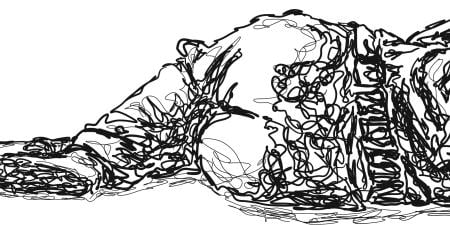Case
On a bitterly cold January evening in New York City, Mr. McCaffrey, a 63-year-old homeless man well known to the hospital, came into the emergency room complaining of generalized weakness, intense pain on coughing, and pain suggestive of a heart attack.
Dr. Edwards, a first-year resident, interviewed Mr. McCaffrey, consulted with the attending physician, and subsequently ordered a number of tests. All tests were negative, suggesting that Mr. McCaffrey did not have a heart attack.
Dr. Edwards began to suspect that her patient was malingering. She spoke with Mr. McCaffrey, who confessed that he was hungry and didn't want to endure the cold weather outside. It was clear that Mr. McCaffrey was in suboptimal health because of his homelessness and age and it was quite possible that, if the hospital were to put him on the street, he might return as a result of a heart attack or with pneumonia.
On the other hand, using the emergency room for nonmedical purposes drains resources (e.g., time, patient rooms, and caregiver energy). Dr. Edwards wondered how far she should go to check out Mr. McCaffrey's complaint each time he showed up. What should the treatment plan be for this returning patient?
Commentary 1
I know Mr. McCaffrey. He has bipolar disease and routinely visits my emergency department. After his wife died he lost his job, started drinking again, and now lives behind a store in an alley. When he's not in jail for illegal lodging or public intoxication, he is at detox or in our emergency department. When paramedics call to announce his arrival, someone invariably says, "When are they going to do something about Mr. McCaffrey?" The emergency-department staff at our sister hospital knows him just as well as we do.
Usually one of his friends calls 9-1-1 if he mentions shortness of breath or chest pain. He often spends 4 hours in an acute-care bed awaiting lab results, x-rays, a CT scan, and a meal. When he is sober enough to walk to the bathroom he usually wants to leave. Every visit represents at least $1,000 in uncompensated care, and those visits now total more than 50. Social workers refer to him as noncompliant. He explains that he simply hates shelters because they are dangerous and his backpack is always getting stolen. Last winter he was admitted for pneumonia and had a non-ST segment elevation myocardial infarction (non-STEMI). He did well on mood stabilizers until discharge but never followed up with a physician. It's no surprise that staff feel frustrated and even angry whenever he arrives. Now, on this icy cold night a young resident named Dr. Edwards is assigned to Mr. McCaffrey, who has come in complaining of chest pains.
Since the passage of Emergency Medical Treatment and Active Labor Act (EMTALA) in 1986, emergency departments in the United States have progressively become medical-care providers of last resort for millions of individuals. Emergency departments operate around the clock and are an essential component of the public health safety net. Unfortunately, the resources to meet the needs of all emergency-department patients are rarely available--particularly on nights, weekends, and holidays. The case of Mr. McCaffrey illustrates how emergency physicians can find themselves with an empty toolbox and must compromise to meet their responsibilities to patients and themselves.
As physicians, we are guided by ethical values that include beneficence, nonmaleficence (i.e., do not harm), respect for autonomy, justice, dignity, truthfulness, and honesty. You're not likely to hear the nuances of these terms debated in a busy emergency department, but they do direct the proper approach to all good decision making. Clinical medicine teaches that we begin with a careful history and physical examination to derive an accurate differential diagnosis and thoughtful plan. From the initial vital signs to a final review of lab results, we search for clues, employ pattern recognition, weigh risk, and attempt to match resources with perceived need.
Mr. McCaffrey's evaluation should follow the same procedure. Emergency physicians often work backwards from worst- to best-case scenario, particularly when evaluating patients with complaints like chest pain that can represent a life-threatening condition. Since emergency care is episodic rather than long term, it is imperative that Dr. Edwards start off on the right foot with Mr. McCaffrey. Her first words and mannerisms must convey a sense of caring. "Hello Mr. McCaffrey, my name is Dr. Edwards. How I can help you today?" They should reflect genuine concern if she is to convince him of any future recommendation. She must also avoid bias from prior references to "frequent flier" that may appear in his medical record. To maintain objectivity, her next question should be, "What is different tonight that made you come to the emergency department?" The answer to that question defines the trajectory of the work-up and sets the goals of the encounter.
In 2008, the minimum standard work-up for a 63-year-old man with a prior non-STEMI and ischemic-sounding chest pain is a 12-lead ECG, chest x-ray, and a 6-hour set of cardiac markers. This is the recommendation regardless of the number of the patient's prior visits to the emergency department unless a recent angiogram has ruled out significant coronary disease. After Dr. Edwards excludes acute coronary syndrome and its mimics, her job is to develop a final disposition for Mr. McCaffrey by weighing his chronic medical, social, and mental health conditions. She recognizes his unfortunate circumstances and, given that it is midnight, neither she nor he wants to see him return to the icy streets. He may have survived the past 10 years on those streets but his chronic homelessness (i.e., continuous homelessness for over 1 year) places him at increased risk for premature death [1]. Tonight, he simply has acute bronchitis, but he could once again develop bacterial pneumonia. The real problem is that a combination of homelessness, poverty, and untreated mental illness has trapped him in a revolving door that opens only to the streets, jail, detox, and the emergency department.
The number of individuals like Mr. McCaffrey who are being cared for in U.S. emergency departments every day is relatively small but these frequent users of services consume enormous acute-care resources without appreciable gain [2]. They repeatedly visit emergency departments rather than primary care clinics with complex needs that cannot be addressed in this setting, and emergency physicians are at a loss to provide anything but short-term solutions. They face daunting barriers to medical and mental health care, substance abuse treatment, and housing, and, as a result, disproportionately tax the time and resources of police, fire, jails, emergency shelters, businesses, and courts.
Until recently, little consideration has been paid to the problems of this population. Over the last 5 years, the Boston HealthCare for the Homeless Program identified 18,834 emergency department visits by 119 chronically homeless individuals [3]. And over 4 years, 529 chronically homeless alcoholics in the San Diego area amassed 3,318 emergency department visits, 652 hospital admissions, and health care bills totaling $17.7 million [4]. In Washington during 2002, 198 of the 130,000 participating adults generated 9,000 emergency department visits and consumed 19 percent of all Medicaid expenditures [5].
Fortunately, some communities are testing novel approaches for these patients. The San Diego Serial Inebriate Program (SIP) provides housing and treatment in lieu of custody to chronically homeless people who are alcoholics [4]. From 2000 to 2003, SIP reduced episodic emergency department visits, improved rates of sobriety, and produced cost savings of more than $70,000 per month. The California Frequent Users of Health Services Initiative published the results of six separate county pilot programs [2]. When patients were connected with housing, income benefits, health insurance, and a primary care home, a 61 percent decrease in emergency department visits and a 62 percent decrease in inpatient days occurred over 2 years.
Unfortunately, Dr. Edwards has no such program at her disposal. She needs a utilitarian, short-term plan so she can see her next patient. In this situation, the principle of primum non nocere (first, do no harm) guides emergency medicine decision making. Dr. Edwards must exclude any plan that carries undue risk of further injury. She should reassess her patient's physical and mental capacity and employ basic common sense to assess his ability to function. For example, if Mr. McCaffrey cannot walk without assistance, he requires admission.
If Mr. McCaffrey can ambulate independently, his needs on this night are essentially shelter and food. Dr. Edwards must also assess his decision-making skills to be certain there is no reason to hold him involuntarily. If he possesses the basic faculties to care for himself, she can fashion a solution that provides both temporary shelter and a bridge to further care. Given the fact that the emergency department waiting room is full (and assuming no emergency shelter is available by cab) she should consider discharging him to the hospital lobby until morning. Provided her attending is in agreement, she should notify hospital security and the nursing staff of her plan. Next, she should explain to Mr. McCaffrey that she believes this is the best among a limited set of options and seek his approval. She should place a referral for a social work consult in the morning, request an outpatient cardiology evaluation of his chest pain, and document their discussion.
At least for 1 night, Dr. Edwards can feel satisfied she has provided Mr. McCaffrey with safety. She can take less comfort from the realization that this scenario is likely to be repeated. A more satisfying solution for Dr. Edwards would be to discuss this case at a departmental conference. Greater awareness of the extraordinarily negative impact of even a single frequent user like Mr. McCaffrey can result in systemic improvement [6]. By opening a discussion of frequent users, she will most likely identify other champions for change of the unacceptable status quo.
References
-
O'Connell J. Premature mortality in homeless populations: a review of the literature. 2005. http://www.nhchc.org/PrematureMortalityFinal.pdf. Accessed December 3, 2008.
-
Linkins KW, Brya JJ, Chandler DW. Frequent users of health services initiative: final evaluation report. 2008. http://documents.csh.org/documents/fui/FUHSIEvaluationReportFINAL.pdf. Accessed November 16, 2008.
-
O'Connell J, Swain S. Rough sleepers: a five year prospective in Boston, 1999-2003. Presentation, MHSA 10th Annual Ending Homelessness Conference. Waltham, MA, 2005.
- Dunford JV, Castillo EM, Chan TC, Vilke GM, Jenson P, Lindsay SP. Impact of the San Diego Serial Inebriate Program on use of emergency medical resources. Ann Emerg Med. 2006;47(4):328-336.
-
Washington State Department of Social and Health Services. Frequent emergency room visits signal substance abuse and mental illness. 2004. http://www1.dshs.wa.gov/pdf/hrsa/dasa/ResearchFactSheets/11119er0604.pdfAccessed November 16, 2008.
-
Gladwell M. Million-dollar Murray. The New Yorker. February 13, 2006:96-107.



